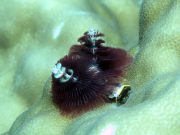Fanworms are very well-known worms owing to their colourful radiolar crown, with one species in particular spotted at many sites when diving around Koh Lanta.
The crown is covered in densely packed microscopic projections that look like tiny hairs in a feather-like feeding and respiratory structure. This structure is attached to a lobe surrounding the mouth. Adult Serpulidae range in size from 2mm to well over 100mm.
Fanworms build hard tubes of crystalline calcium carbonate which are sometimes embedded in coral. The calcareous tube is usually white, though can also be blueish or pink, and is several times the length of the animal. Members of this family have a modified radiole (primary branch of the crown) which blocks the entrance of their tubes when they withdraw into the tubes.
These worms tend to have redish pigmentation on the radiolar crown and the forward part of their body. Some, such as christmas tree worms have white, yellow, orange, blue, brown or purple radiolar crowns.
1 species found on this page.



